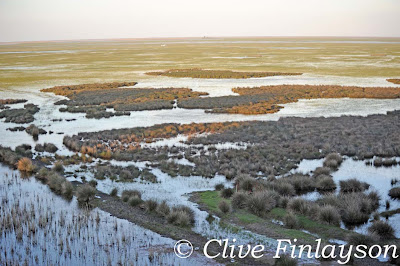Purple Heron
Now that the flood waters are receding the marshes of the Guadalquivir are looking splendid and rich in food for many aquatic birds. Among the best represented are the great fishermen of the marshes - the herons. These photographs, with two exceptions indicated, were taken on 23rd April and in March of this year. They serve to illustrate the huge biomass that these marshes are able to support in good years.
The marsh itself, with a good cover of reeds, is favourite for one of the most elegant of birds. The Purple Heron arrives in spring from tropical West Africa to breed. It spends most of its time among the reeds and is very shy, making the task of the photographer difficult. In spite of its size and colours it has an uncanny ability to stay put and fly just as you see it!
The long neck allows this bird to get an aerial view of the reeds and when a movement is detected a close-up focus takes over.
If luck is with it, as here, an unsuspecting crayfish makes a tasty meal!
gulp!
Where there is more open water, but with the safety of reeds nearby, another large heron takes over. The Great Egret has experienced a significant recovery in the last decade and is now a regular feature of the marshes. Unlike the Purple Heron, the Great Egret stays around all year.
This species also stretches its neckto survey the surroundings
and its long legs allow it to wade deep
The Grey Heron is the largest species and prefers to feed in open water, including shallow pools. It will travel great distances over the marshes to find suitable feeding opportunities.
Like its relatives, it hunts by stealth
Black-crowned Night Herons are highly sociable and are often seen flying to and from feeding grounds at dawn and dusk. They are smaller than the previous species and are sit-and-wait predators, often close to reed beds but near open water.
Night Heron (above) and the equally stunning Squacco Heron (below - archive photo) are predators of fish, crabs and crayfish, taking smaller prey than the larger herons.
There are many ponds and shallow lakes now and these are full of frogs and toads. Along with small fish they are favourite prey of the elegant Little Egret.
The least orthodox in the family is the Cattle Egret that prefers to follow sheep and cattle, often in large flocks, and take the insects they disturb than follow the family tradition of fishermen. Even so they are often seen close to water as if old habits died hard!
The smallest species, the Little Bittern (above - archive photo), is highly migratory and, like the Purple Heron, returns to these marshes after a crossing of the Sahara Desert.



































.jpg)



















